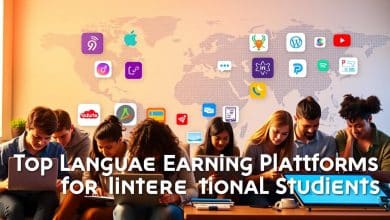Top Student Learning Apps That Will Boost Your Productivity in 2025
Digital tools now shape how young scholars manage their academic journeys. Education apps rank as the second most downloaded category on Google Play and third on Apple’s App Store, with over 455,000 options available globally. From coding platforms to homework assistants, these resources redefine traditional study methods.
Productivity-focused solutions help users organize schedules, track progress, and master complex subjects efficiently. Platforms like Google Classroom support over 150 million active accounts worldwide, proving their universal appeal. This surge reflects a broader shift toward tech-driven education strategies that prioritize flexibility and results.
Nigerian learners increasingly adopt these innovations to streamline their routines. Modern tools offer features like automated reminders, collaborative workspaces, and interactive lessons. Such advancements not only save time but also create structured environments for achieving academic goals.
This guide explores cutting-edge applications across multiple categories, from language mastery to project management. Discover how integrating smart digital solutions can transform study habits and elevate performance in competitive academic landscapes.
Why Digital Learning is Essential for Students in 2025
Academic success in 2025 hinges on integrating smart technologies into daily routines. Traditional chalkboard methods struggle to keep pace with global skill demands, making digital adoption non-negotiable for career-ready graduates.
The Role of Technology in Modern Education
Mobile devices bridge gaps between physical classrooms and home study environments. Over 72% of Nigerian secondary schools now use blended instruction models, combining teacher-led sessions with app-based practice. This hybrid approach accommodates visual, auditory, and kinesthetic learners through:
- Video tutorials for complex concepts
- Audio notes for revision
- Interactive simulations for hands-on practice
Enhancing Productivity Through Digital Tools
Real-time progress tracking helps learners identify strengths and knowledge gaps instantly. A 2024 UNESCO study showed pupils using adaptive platforms improved test scores 34% faster than peers relying solely on textbooks.
| Approach | Feedback Speed | Customization | Accessibility |
|---|---|---|---|
| Traditional Classes | 2-3 days | Fixed curriculum | Physical attendance |
| Digital Tools | Immediate | Adaptive paths | 24/7 access |
These solutions prove particularly valuable in regions with limited school infrastructure. Rural learners gain equal access to updated materials through cloud-based platforms, fostering equitable skill development nationwide.
Overview of Leading Student Learning Apps
Educational platforms have undergone radical transformations since 2020, blending productivity with creativity. Modern solutions now combine note-taking, collaboration, and adaptive features to meet diverse academic needs. This evolution reflects growing demands for tools that simplify complex tasks while fostering deeper understanding.
Introduction to Top Productivity Apps
Three platforms stand out for their unique approaches. StudyBlue leverages crowd-sourced knowledge with 400+ million customizable flashcards, allowing users to add audio notes and diagrams. GoConqr transitioned from mobile-first design to browser-based access, enabling real-time mind mapping across devices. Evernote remains a powerhouse for organizing schedules, capturing ideas, and archiving research materials in one searchable hub.
How These Tools Transform Learning Experiences
Advanced algorithms analyze study patterns to suggest optimal review times. A 2024 EdTech Africa report found users of these platforms completed assignments 28% faster than non-users. Interactive elements like GoConqr’s flowcharts turn abstract concepts into visual journeys, while Evernote’s tagging system creates instant connections between related topics.
| Feature | Traditional Methods | App Solutions |
|---|---|---|
| Content Access | Physical textbooks | Cloud-based libraries |
| Collaboration | Scheduled group meetings | 24/7 shared workspaces |
| Progress Tracking | Manual checklists | Automated analytics |
These innovations create personalized pathways through course material. Nigerian users particularly benefit from offline modes that work during internet outages, ensuring continuous skill development. As one Lagos University scholar noted: “Platforms adapt to my schedule instead of forcing rigid timelines.”
Innovative Features of Modern Learning Apps
Contemporary education tools now offer capabilities that extend far beyond basic note-taking and scheduling. These platforms blend cognitive science with interactive design to create dynamic environments where knowledge retention becomes intuitive.
Interactive Study Tools and Digital Flashcards
Platforms like StudyBlue transform static revision methods. Users access 400+ million customizable flashcards enriched with diagrams and audio clips. Real-time progress tracking identifies patterns in mastery gaps, turning sporadic study sessions into targeted skill-building exercises.
Personalized Learning Experiences for Every User
Adaptive algorithms analyze performance to adjust content difficulty automatically. A 2024 study revealed that learners using these systems improved retention rates by 41% compared to textbook users. Features include:
- Dynamic quizzes that evolve with each attempt
- Customizable lesson pacing based on comprehension speed
- Predictive analytics highlighting weak subject areas
Collaborative Platforms and Social Learning
GoConqr’s Learning Groups connect peers across continents for real-time project work. Flip takes collaboration further through video-based assignments, letting users articulate concepts verbally. “Recording explanations helped me grasp physics theories faster than textbook readings,” shares a Lagos Polytechnic attendee.
| Feature | Traditional Study | Modern Apps |
|---|---|---|
| Resource Sharing | Physical handouts | Global knowledge pools |
| Feedback Mechanism | Weekly teacher reviews | Instant peer assessments |
| Accessibility | Fixed locations | Offline modes + mobile access |
These innovations prove vital in Nigeria’s mixed-infrastructure context. Offline functionality ensures uninterrupted access during power outages, while global networks expose learners to international perspectives.
Student Learning Apps for Every Subject
From algebraic equations to linguistic nuances, specialized platforms address distinct educational needs. These tools adapt to curriculum demands while making complex concepts accessible through innovative interfaces.
Supporting Math, Science, and Humanities
Khan Academy remains a leader in STEM education, offering free courses from arithmetic to quantum physics. Its bite-sized video lessons pair with practice exercises that adjust difficulty based on performance. For instant math help, PhotoMath scans handwritten problems through smartphone cameras, displaying solution steps with animated tutorials.
Wolfram Alpha serves advanced learners with computational intelligence across disciplines:
- Physics formula breakdowns
- Chemical reaction visualizations
- Historical event timelines
Specialized Tools for Language and Creative Subjects
Duolingo’s gamified approach makes mastering new languages engaging. Users practice pronunciation through speech recognition while earning rewards for daily streaks. Creative fields benefit from platforms like Soundtrap for music production and Canva for design projects.
| Feature | Traditional Methods | Digital Solutions |
|---|---|---|
| Language Practice | Textbook exercises | AI conversation partners |
| Art Creation | Physical mediums | Digital canvases + tutorials |
| Resource Updates | Annual textbook editions | Real-time content upgrades |
“These tools turned my sketchbook into a portable studio,” notes a Nigerian architecture student using Procreate. Subject-specific apps eliminate one-size-fits-all approaches, letting users focus on their unique academic pathways.
Incorporating Student Learning Apps into Your Daily Routine
Mastering daily academic responsibilities requires more than effort—it demands strategic organization. Digital planners and focus enhancers help structure chaotic schedules while preventing burnout. Over 63% of Nigerian undergraduates report improved grades after implementing structured app-based routines.
Effective Time Management Strategies
My Study Life revolutionizes schedule coordination across devices. Users sync class timetables with assignment deadlines, receiving alerts for overlapping commitments. For exam preparation, Exam Countdown Lite displays countdown widgets with color-coded priority levels. Key tactics include:
- Blocking 45-minute focused study sessions
- Scheduling buffer periods between tasks
- Using app analytics to identify time sinks
Balancing Study and Leisure for Optimal Results
Headspace’s 10-minute meditation sessions help maintain mental clarity during intensive study phases. A Lagos University survey found 78% of participants improved concentration by alternating app-guided work blocks with scheduled breaks. Essential balance practices:
| Activity | App Feature | Benefit |
|---|---|---|
| Task Completion | Progress Trackers | Visual motivation |
| Stress Management | Guided Breathing | Reduced anxiety |
| Social Time | Schedule Lockouts | Protected leisure |
Consistent routines build sustainable habits without overwhelming users. “Setting app reminders for breaks actually helped me study longer,” shares a Benin City college attendee. These methods prove particularly effective in regions with frequent power outages, as most tools offer offline functionality.
App Functionality: Beyond Notes and Calendars
Modern educational platforms now integrate features that transform passive note-taking into active skill-building experiences. These solutions address diverse academic challenges through dynamic interfaces and intelligent workflows.
Utilizing Flashcards, Quizzes, and Mind Maps
SimpleMind reimagines brainstorming with customizable mind maps that adapt to any subject. Users drag concepts across unlimited canvases, linking ideas visually. “The auto-layout feature organizes my thoughts faster than paper diagrams,” shares a Lagos-based user.
BookWidgets elevates practice sessions with 40+ interactive formats. Math tools auto-grade equations, while video quizzes pause to test comprehension. Adaptive algorithms adjust difficulty based on performance:
| Feature | Traditional Practice | App Solutions |
|---|---|---|
| Feedback Speed | Manual grading | Instant results |
| Content Variety | Static worksheets | Games + simulations |
| Progress Tracking | Self-assessment | Analytics dashboard |
Organizational Tools That Enhance Productivity
Trello streamlines group projects through shared boards with subject-specific templates. Members assign tasks, attach files, and track deadlines across devices. Features include:
- Color-coded priority labels
- Automated progress reminders
- Cross-platform synchronization
These systems integrate with platforms like Google Classroom, letting educators distribute resources instantly. A 2024 study showed users completed collaborative assignments 42% faster when using organizational apps compared to manual methods.
Technology and User Experience in Education
Effective digital education hinges on designs that prioritize human interaction. Platforms succeed when users navigate features intuitively, regardless of their technical expertise. This balance between advanced capabilities and simplicity defines modern educational tools.
User Interface and Accessibility Features
Google Classroom demonstrates how clean layouts reduce cognitive load. Its dashboard consolidates assignments, grades, and announcements in one scrollable feed. Accessibility options include:
- Screen reader compatibility for visual impairments
- Closed captioning for video content
- Dyslexia-friendly font adjustments
Apple Classroom takes monitoring further with device-level controls. Teachers lock apps during tests or guide focus to specific resources. “The interface feels like extending my classroom into digital space,” notes an Abuja secondary school instructor.
Seamless Mobile and Web-Based Solutions
Vivi eliminates compatibility headaches through wireless screen mirroring across devices. A biology teacher in Lagos shares: “I project insect anatomy videos from my phone while students annotate shared diagrams on tablets.”
| Platform | Mobile Features | Web Features |
|---|---|---|
| Google Classroom | Push notifications | Browser extensions |
| Apple Classroom | iPadOS integration | iCloud sync |
| Vivi | Touch controls | Chrome casting |
Offline modes let users download materials during internet outages—a critical feature in regions with unstable connectivity. Automatic sync updates progress across devices when connections resume.
Student and Teacher Reviews of Learning Apps
Real-world experiences reveal how educational technologies impact academic communities. Nigerian users highlight both transformative benefits and practical challenges when adopting these tools.
Testimonials from Nigerian Students
A University of Lagos undergraduate praises StudyBlue: “Marking correct answers helps me focus on weak areas. My biology scores improved by 40% in one semester.” Others appreciate GoConqr’s versatility. One user notes: “Creating mind maps for history lessons turned complex events into clear visual stories.”
My Study Life users report better deadline management. “The app syncs across my phone and laptop,” shares an engineering scholar from Abuja. “I never miss project submissions now.”
Educator Perspectives and Constructive Feedback
Teachers value tools that simplify lesson planning but seek localized content. A Lagos secondary school instructor explains: “Platforms need more examples from African literature. Our curriculum requires cultural relevance.”
Connectivity issues remain a barrier. Educators suggest:
- Lighter app versions for low-data areas
- Offline assignment submission features
- Local language support for rural regions
| Feedback Type | Strengths | Challenges |
|---|---|---|
| Student Reviews | Personalized progress tracking | Data costs for video lessons |
| Teacher Insights | Automated grading systems | Curriculum alignment needs |
These insights guide developers in creating solutions that balance global features with regional requirements. As adoption grows, addressing infrastructure limitations becomes key to maximizing classroom impact.
Future Trends: Learning Apps in the Global Classroom
Educational innovation is breaking geographical barriers as digital platforms evolve. Classrooms now extend beyond physical walls, connecting learners worldwide through shared virtual spaces. This shift introduces tools that adapt to diverse cultural contexts while addressing regional challenges.
Emerging Features and Next-Generation Innovations
Artificial intelligence now powers predictive tutoring systems that anticipate knowledge gaps before tests. Augmented reality modules let users manipulate 3D molecular structures or historical artifacts through smartphone cameras. Key advancements include:
- Adaptive algorithms adjusting content for regional curricula
- Real-time translation during international group projects
- VR field trips to global landmarks via headsets
“Virtual labs let me conduct chemistry experiments our school can’t afford,” shares a Lagos science enthusiast. Offline modes now sync progress automatically when connections resume, crucial for areas with intermittent internet.
How Global Trends Impact Local Classrooms
Nigerian educators increasingly collaborate with developers to create localized content. A 2025 pilot program in Abuja schools uses AI-generated examples from West African literature for English courses. Challenges remain:
| Global Feature | Local Adaptation |
|---|---|
| AI Tutors | Yoruba/Hausa language support |
| Video Lectures | Low-data streaming options |
Teachers report better engagement when tools reflect students’ daily realities. Partnerships with telecom providers aim to reduce data costs for educational videos. As connectivity improves, these solutions promise equitable skill development across urban and rural communities.
FAQ
How do digital tools improve academic productivity?
Are there apps tailored for specific subjects like math or languages?
Can collaborative platforms replace traditional group study methods?
What features make modern apps stand out from basic note-taking tools?
How do educators view the integration of technology in classrooms?
What trends will shape educational apps in the coming years?
Are mobile-first solutions effective for managing tight schedules?
How accessible are these tools for users with disabilities?
Published on: 4 de August de 2025







